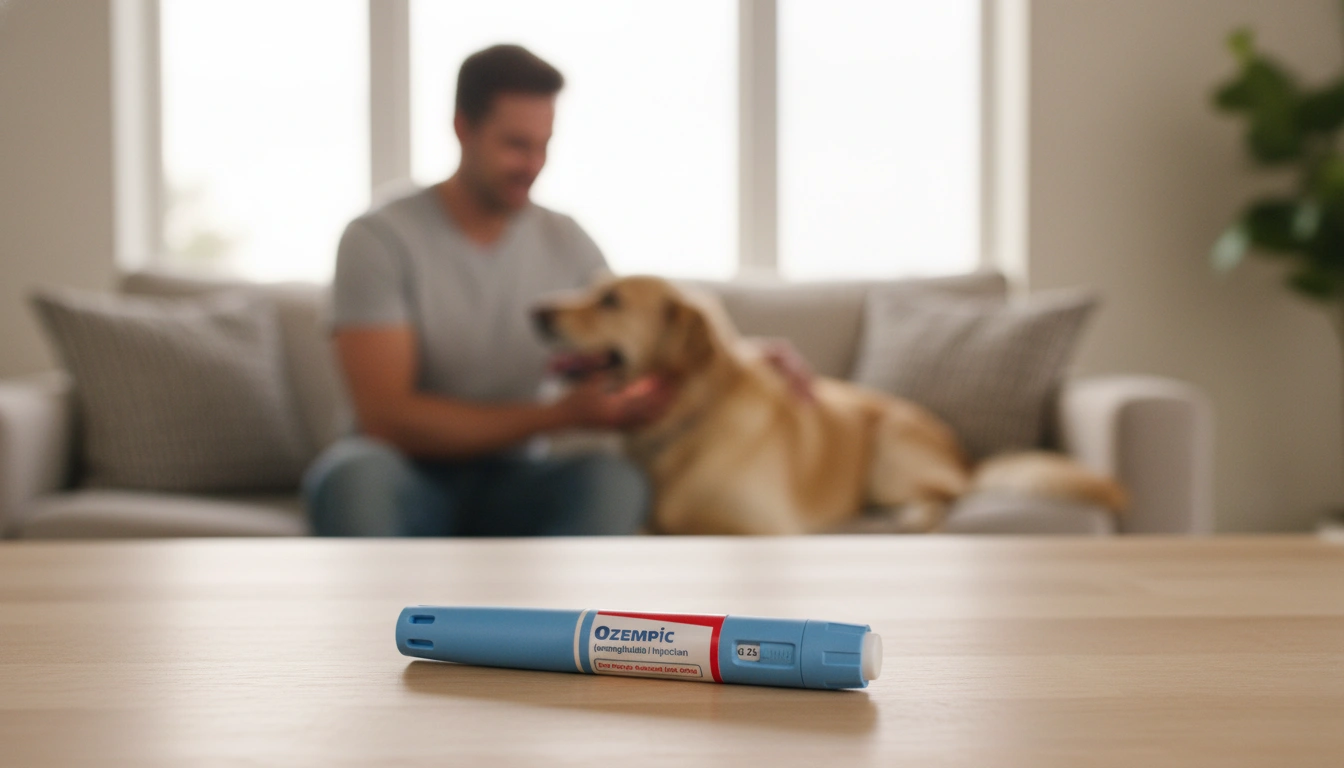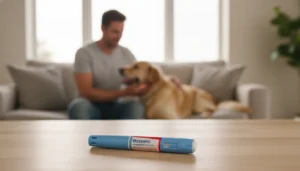How to Use Ozempic: A Comprehensive Guide to Your Weight Loss Journey

Introduction
Did you know that about 42% of American adults are classified as obese? This staggering statistic underscores the growing health crisis we face today, and many individuals are seeking effective solutions to manage their weight. One such solution that has gained attention is Ozempic, a medication originally approved for managing type 2 diabetes. While the primary purpose of Ozempic is to lower blood sugar levels, many people have turned to it for its secondary benefit: weight loss.
In this blog post, we will explore how to use Ozempic effectively, its benefits and potential side effects, and why it might be a viable option for those struggling with weight management. By the end of this guide, you'll have a clear understanding of how to incorporate Ozempic into your weight loss journey, along with insights into the importance of personalized care in achieving sustainable results.
At TrimRx, we believe that weight loss should be approached with science, empathy, and transparency. Our mission is to empower individuals to embrace healthier lifestyles through personalized, medically supervised weight loss solutions. If you're interested in exploring how Ozempic might fit into your weight loss plan, we encourage you to take our free assessment quiz to see if you qualify for our prescription weight loss medications.
Let's embark on this journey together as we dive into the details of using Ozempic for weight management.
Understanding Ozempic
Ozempic (semaglutide) is a GLP-1 receptor agonist, which means it mimics a hormone in the body that regulates blood sugar levels and appetite. Approved by the U.S. Food and Drug Administration (FDA) in 2017 for the treatment of type 2 diabetes, Ozempic has been shown to help with weight loss as a secondary benefit. It works by increasing insulin secretion, slowing gastric emptying, and promoting a feeling of fullness after meals.
How Ozempic Works
The primary function of Ozempic is to improve glycemic control in patients with type 2 diabetes. However, many individuals have reported significant weight loss while using the medication. Ozempic achieves this through several mechanisms:
- Appetite Regulation: Ozempic helps to regulate your appetite by signaling to your brain when you're full, which can reduce the overall amount of food you consume.
- Delayed Gastric Emptying: By slowing down how quickly food leaves your stomach, Ozempic helps you feel satisfied for longer periods after eating.
- Improved Insulin Sensitivity: As your blood sugar levels stabilize, your body becomes more efficient at using insulin, which can further aid in weight management.
Benefits of Using Ozempic for Weight Loss
While Ozempic is not FDA-approved specifically for weight loss, many healthcare providers prescribe it off-label to assist with weight management. Here are some of the benefits associated with its use:
- Effective Weight Loss: Clinical studies have shown that individuals using Ozempic can achieve significant weight loss when combined with lifestyle changes such as diet and exercise.
- Improved Overall Health: Losing weight can lead to a reduction in the risk of obesity-related conditions, including heart disease, high blood pressure, and type 2 diabetes.
- Convenient Administration: Ozempic is administered via a once-weekly injection, making it easier to incorporate into a busy lifestyle.
How to Use Ozempic
Using Ozempic correctly is essential for maximizing its benefits and minimizing any potential side effects. Below, we outline a step-by-step guide on how to use Ozempic safely and effectively.
Step 1: Preparing Your Ozempic Pen
Before using your Ozempic pen for the first time, you must ensure it is properly prepared:
- Storage: Store unopened pens in the refrigerator between 36°F to 46°F (2°C to 8°C). Once in use, the pen can be kept at room temperature (between 59°F to 86°F or 15°C to 30°C) for up to 56 days.
- Check the Label: Verify that the pen label matches the prescribed medication, ensuring you have the correct dosage.
- Inspect the Solution: The solution should be clear and colorless. Do not use it if it appears cloudy or discolored.
Step 2: Attaching a New Needle
For each injection, it is crucial to use a new needle to reduce the risk of infection and ensure proper dosage:
- Remove the Paper Tab: Tear off the paper tab from the new needle.
- Attach the Needle: Push and twist the needle onto the pen until it is secure.
- Remove the Caps: Carefully pull off the outer and inner caps of the needle.
Step 3: Performing a Flow Check
Before your first injection with a new pen, it's important to perform a flow check to ensure the pen is working correctly:
- Select the Flow Check Symbol: Turn the dose selector until it shows the flow check icon.
- Press the Dose Button: Hold down the dose button until the dose counter shows '0.' A drop of Ozempic should appear at the needle tip.
Step 4: Selecting Your Dose
Once you've confirmed the pen is ready, it's time to select the appropriate dosage:
- Set the Dose: Turn the dose selector until the dose counter shows the prescribed amount. Common starting doses are typically 0.25 mg or 0.5 mg, but follow your healthcare provider's recommendations.
Step 5: Injecting Ozempic
Now that your pen is ready, you can proceed with the injection:
- Choose an Injection Site: Suitable areas include the abdomen, thigh, or upper arm. Rotate injection sites to minimize discomfort.
- Clean the Skin: Use an alcohol swab to clean the skin where you will inject.
- Insert the Needle: Pinch the skin to create a fold and insert the needle at a 90-degree angle.
- Administer the Dose: Press and hold the dose button until the dose counter returns to '0.' Count slowly to six before removing the needle to ensure the full dose is delivered.
Step 6: After Injection Care
After administering your injection, it's vital to dispose of the needle properly:
- Dispose of the Needle: Place the used needle in an FDA-cleared sharps disposal container immediately.
- Store the Pen: Replace the pen cap and store it as instructed, keeping it away from heat and light.
Important Safety Information
While Ozempic can be beneficial, it is essential to be aware of its potential side effects:
- Common Side Effects: Nausea, vomiting, diarrhea, constipation, and stomach pain.
- Serious Side Effects: Pancreatitis, kidney issues, and allergic reactions. If you experience persistent stomach pain or signs of an allergic reaction, seek medical attention immediately.
Before starting Ozempic, it's crucial to discuss your medical history with your healthcare provider, especially if you have a history of pancreatitis or thyroid issues.
Lifestyle Considerations for Optimal Results
At TrimRx, we understand that weight loss is not solely about medication; it's a holistic journey that involves lifestyle changes. Here are some recommendations to enhance the effectiveness of Ozempic:
Diet
- Balanced Nutrition: Focus on a well-rounded diet rich in fruits, vegetables, lean proteins, and whole grains. This will not only support your weight loss efforts but also improve your overall health.
- Portion Control: Be mindful of portion sizes to help regulate calorie intake, especially when using Ozempic, which can help you feel fuller.
Exercise
- Regular Physical Activity: Aim for at least 150 minutes of moderate-intensity exercise each week. Incorporating both cardio and strength training can enhance weight loss and improve overall fitness.
- Set Realistic Goals: Begin with achievable fitness goals and gradually increase the intensity and duration of your workouts.
Support Systems
- Stay Connected: Engage with a support system, whether it be friends, family, or a community group. Sharing your journey can provide motivation and accountability.
- Seek Professional Guidance: Consider working with a healthcare provider or a registered dietitian who can offer personalized advice and support tailored to your unique needs.
Conclusion
As we have explored in this guide, Ozempic can be a valuable tool in your weight loss journey when used correctly and in conjunction with healthy lifestyle changes. By understanding how to use Ozempic safely and effectively, you can maximize its benefits and make significant progress toward your weight management goals.
At TrimRx, we are committed to providing personalized weight loss solutions that are safe, effective, and tailored to your individual needs. If you are considering Ozempic as a part of your weight loss journey, we invite you to take our free assessment quiz to see if you qualify for our prescription weight loss medications. Together, we can help you embrace a healthier lifestyle and achieve your weight loss goals.
FAQ
What is Ozempic used for?
Ozempic is primarily used to manage blood sugar levels in individuals with type 2 diabetes but is also noted for its weight loss effects.
How should I store my Ozempic pen?
Unopened pens should be stored in the refrigerator. Once opened, they can be kept at room temperature for up to 56 days.
Can I use Ozempic if I don’t have diabetes?
While Ozempic is not approved for weight loss, some healthcare providers may prescribe it off-label for weight management. Always consult with your healthcare provider first.
What are the common side effects of Ozempic?
Common side effects include nausea, vomiting, diarrhea, and constipation. Serious side effects can occur, so be sure to monitor your health.
How often do I need to take Ozempic?
Ozempic is administered as a once-weekly injection, making it convenient to incorporate into your routine.
For more personalized guidance on weight loss and to explore our range of effective solutions, please visit TrimRx and take our assessment quiz today. Together, we can support you on your journey to a healthier life!

Transforming Lives, One Step at a Time
Keep reading
Skipping an Ozempic Dose: What You Need to Know
Discover what happens if you skip an Ozempic dose. Learn about immediate and long-term effects, plus expert advice on how to get back on track safely. Don’t risk your progress!
Ozempic Dosing: What is the Therapeutic Dose for Type 2 Diabetes Management?
Curious what is the therapeutic dose for Ozempic? Discover how personalized dosing optimizes blood sugar control & weight management. Learn more now!
Navigating Ozempic Dosing: What is the Smallest Dose of Ozempic and Why It Matters
Curious about what is the smallest dose of Ozempic? Learn why 0.25 mg is the starting point, how it works, and its role in a safe, effective weight loss journey. Discover personalized support today!



